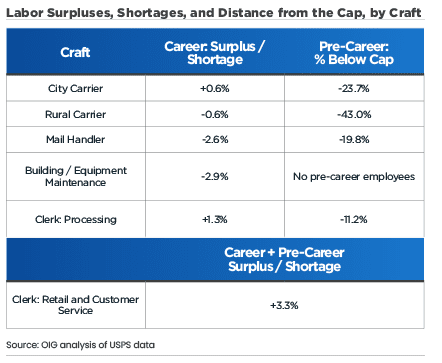- The Postal Service navigated a volatile U.S. labor market in recent years and saw declining mail volume and a growing share of packages impact the composition of its workforce.
- Between fiscal years (FYs) 2019 and 2023, USPS added 8,105 employees — a 1.3 percent increase over the 5-year period.
- Despite a tight U.S. labor market, the Postal Service did not experience a substantial surplus or shortage of career employees in any craft in FY 2023. However, some districts and divisions bucked the trend.
- The pre-career employee cap represents a hiring ceiling and not necessarily the number of pre-career employees USPS believes it needs to be fully staffed. However, pre-career employees on roll trailed the cap by double digits in every craft in FY 2023.
- The Postal Service may face a retirement wave in the coming years with more than 50 percent of craft employees eligible to retire within the next decade.
Declining mail volume and a growing share of parcels in the mail mix have impacted the composition of the Postal Service’s workforce in recent years. Additionally, the U.S. labor market experienced dramatic swings, cratering in the early days of the COVID-19 pandemic, then tightening considerably as organizations struggled to recruit, hire, and retain employees.
The USPS OIG found the Postal Service added 8,105 employees between FYs 2019 and 2023, a 1.3 percent increase over the 5-year period. In percentage terms, the number of mail handlers grew the most, increasing by 18.8 percent. Clerks rose by 1.9 percent, while the number of city carriers fell by less than half of one percent, rural carriers declined by 3.1 percent, and building and equipment maintenance employees fell by 6.1 percent.
The OIG found no craft had a substantial shortage or surplus of career employees on average in FY 2023. Across all five crafts, the largest deficit was 2.9 percent (building and equipment maintenance employees) and the largest surplus was 1.3 percent (career processing clerks). However, some of USPS’s 50 districts and 13 divisions had substantially larger shortages or surpluses than the Postal Service as a whole.

Among the pre-career workforce — who do not receive the same level of benefits as career employees — the OIG found the number of employees on roll trailed the pre-career employee cap by double digits in every craft in FY 2023. The cap, negotiated with labor unions, is the maximum number of pre-career employees the Postal Service is contractually allowed to have on roll, and does not necessarily represent the total number of pre-career employees the agency believes it needs to be fully staffed. However, substantially fewer pre-career employees on roll than the cap allows could signal a staffing shortage.
The Postal Service is facing a possible retirement wave, with many employees currently eligible to retire or approaching retirement eligibility in all five crafts. As of November 2023, across all five crafts combined, 19.8 percent of employees were currently eligible to retire, an additional five percent will be eligible in the next year, and 13.1 percent on top of that will be eligible within the next five years. Altogether, over half (52.8 percent) will be eligible to retire within the next decade.



